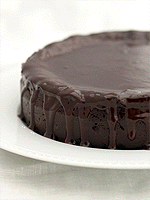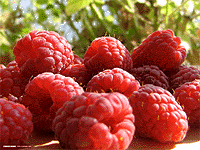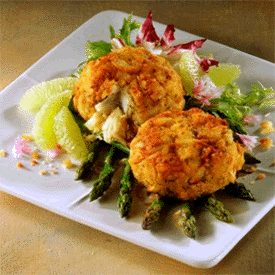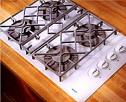|
Recipe
2
Roasted Asparagus
Pre heat the oven to 350 degrees.
Cut the woody tough bottoms
off the stalks. With a vegetable peeler, peel the asparagus from
just below the floweret to the bottom of the stalk.
Place the stalks in a large mixing bowl and add the olive oil.
Toss the stalks until well coated. Place the stalks on an
ungreased cookie sheet Sprinkle with salt to taste.
Grind pepper over stalks to taste.
Put stalks in oven and roast for
5 to 8 minutes, checking
constantly to keep the stalks from over cooking. They should
be hot and still crisp when you serve them. Do not overcook.
Immediately upon removing the stalks from the oven, sprinkle finely grated parmesan cheese to taste over the stalks.
If cheese does not melt sufficiently, return to oven briefly to complete the melting.
SERVE IMMEDIATELY.

|

Ingredients:
4 stalks asparagus per person
(about the size of your little finger)
2 T Olive 0il
(more if you are cooking more than 20 stalks)
Kosher salt
Freshly ground black pepper
1/4 cup finely grated parmesan
Asparagus has umamai and the cheese is also a
classic source of umami.
|
|

Ingredients:
9 oz Schokinag bittersweet chocolate broken into
pieces
(any other high quality chocolate can be substituted)
1/2 cup unsalted butter at room temperature
1/2 cup sugar, divided
5 eggs, separated
1/2 cup finely grated almonds
3 T dark rum
Powdered sugar
Clearbrook Farms Red Raspberry sauce
Fresh raspberries for garnish

|
Recipe
3
Flourless Chocolate Cake
with Raspberry Sauce
Preheat oven to 300 degrees
Grease a 9 inch springform pan with butter
Line the bottom of the pan with a round of parchment paper
Melt the chocolate in a double boiler gently, remove from heat and
allow to cool while assembling other ingredients
Beat butter in a large bowl with 1/4 cup sugar until mixture is fluffy.
Add egg yolks and beat one minute
Add almonds, rum and beat two minutes more
In another bowl, beat the egg whites with the remaining 1/4 cup
sugar until whites are stiff and shiny ( 3 to 5 minutes)
Fold 1/4 of the chocolate mixture into the egg whites gently
Gradually fold the rest of the chocolate mixture mixing gently until
all the white streaks have been eliminated
Pour the mixture into the springform and bake 25 to 30 minutes
Test cake for doneness with an extra long toothpick or bamboo
skewer. Skewer should come out almost clean with a few moist
crumbs clinging to it.
Allow cake to cool for an hour
Run a knife around the springform to loosen the cake
and remove it from the pan. Remove the parchment paper
Sprinkle the cake with a light dusting of powdered sugar, cover
and put in the refrigerator to chill for 3 or four hours or overnight
Garnish each cake slice with a single fresh raspberry and the raspberry sauce.
Serve warm sake with the cake for an extra blast of umami.
|
|
Recipe
4
Savory Sautéed
Crab Cakes
Prepare bread crumbs by taking a good quality white bread , trimming off the crust and reducing the crustless bread to crumbs in a food processor. Place 3/4 cup of the crumbs in a small bowl and add the clam juice. Mix
thoroughly and set aside.
In a large bowl, combine the anchovies, mayonnaise, shallot, parsley, red pepper,
Worcestershire, dijon, Old Bay, Crystal and egg and wet bread crumbs and mix
thoroughly.
Pick over the crab meat to be sure there are no shells and add to the mayonnaise mixture.
Very gently, combine the crab meat with the mayo mixture by hand being sure not to break up the crab meat any more than is
completely necessary. You want as many large lumps as
possible. Season with salt and freshly ground black
pepper to taste.
Using a scoop of your choice to promote uniformity, scoop out a portion of the crab mixture. If it seems too runny, add , a little bit at a time, the remaining dry white bread crumbs.
Coat each cake in Panko and set aside on a cookie sheet. When all the cakes have been formed, cover them and put them in the
refrigerator for at least 2 hours. This step is very important. The cakes will be quite
fragile until they are cooled.
Just before you plan to serve the cakes, heat a large sauté pan over medium high heat and add the butter and olive oil. Do not overheat the oil or it will turn brown. Add the cakes to the pan making sure they do not touch.
Sauté for about two minutes and turn to cook other side. Cakes should be
golden brown and hot throughout.
Serve one or two with a spicy mayonnaise or tarter sauce for an appetizer or three or more for a main course.
Recipe yields about twenty small cakes if you use a
tablespoon scoop.
|

Ingredients:
1 Cup freshly prepared white bread crumbs, divided
4 T bottled clam juice
4 anchovy fillets, minced
1 pound fresh lump crab meat
1/4 cup mayonnaise
3 T finely chopped shallots or white onion
2 T Italian flat parsley, chopped
2 T red bell pepper, finely chopped
1 T Worcestershire
1/4 t or more to taste, Crystal hot sauce
1 large egg
1 cup Panko crumbs
2 T butter
2 T olive oil

|
|
Do You Know Umami?
When we were growing up, there learned that there were four basic tastes: salt, sweet, sour
and bitter. We were told that our taste buds had special taste receptors in particular zones
on our tongues that detected these four tastes and that all other components of flavor came
from our olfactory sense–the sense of smell.
There is a fifth basic taste.
It is called “umami,” and a Japanese scientist named Kitunae Ikeda isolated one compound
which contibutes this taste back in 1908. Working with a seaweed broth, he isolated the
amino acid, glutamate, as one of the sources for the taste which is described as “meaty,
rich, savory and satisfying.” Glutamate itself was already a known substance, having been
discovered in 1866 by a German chemist named Dr. Karl Ritthausen who discovered it while
studying gluten in wheat.
“Umami” itself is a compound Japanese word, from the root words, “umai” meaning “delicious,”
and “mi,” meaning “essence,” and while it is often used to describe the flavor enhancing
ability of the salt form of glutamate, ,monosodium glutamate, that is not the only proper
context for its useage.
In fact, researchers have found that umami accurately describes the flavor of many amino
acids and proteins. In 2000, researchers at the University of Miami discovered the taste
receptor for umami, which essentially proves that umami is a basic taste, for which humans
had evolved a hunger. This receptor, named “taste-mGluR4″ responds not only to glutamate,
but in greater and lesser degrees, to every other amino acid and nucelotide.
Considering the myriad of uses to which amino acids are put in the human body, it is no
wonder we are programmed to enjoy their flavors. Amino acids are necessary in building
muscles, enzymes and other chemicals necessary to bodily function.
So, what does all of this mean to cooks?
Does this mean we need to study chemistry and put MSG in everything?
No.
It means we just need to look at what foods have large supplies of naturally occurring
glutamates and amino acids and combine them with the principles we already know of good
cooking, to help us make our dishes even more delicious.
It isn’t like any of these ingredients are new or anything.
People all over the world have been cooking with glutamate and amino acid rich foods for
thousands of years.
Take a look at the foods surrounding the new cookbook, The Fifth Taste
and think
about how many of them you have in your kitchen right now. If you are like me, you probably
have plenty of umami sitting in your cupboards, refrigerators, shelves and countertops, just
waiting to add goodness to your next meal. A quick glance at my illustration should identify
soy sauce, nori, dried and fresh shiitake mushrooms, red wine, truffle oil, parmesan cheese,
sun dried tomatoes and tomato paste.
Every serious cook in the world is bound to have one or two of those ingredients in their
kitchen at any given time. The concatenation of jars, bottles, tubes, packages and loose
items above are just what I pulled off my shelves this morning when I went on a mission to
find good examples of umami-rich foods.
The Fifth Taste: Cooking With Umami by David and Anna Kasabian.
Copyright © Umami Rich
2007-2012
All Rights Reserved
|



